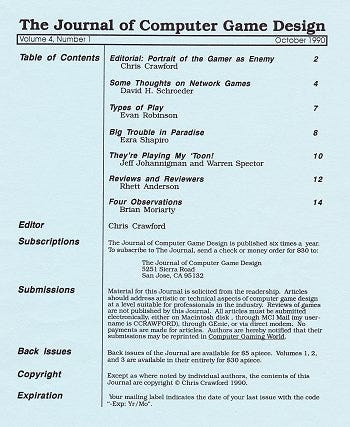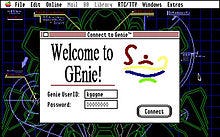Trending
Opinion: How will Project 2025 impact game developers?
The Heritage Foundation's manifesto for the possible next administration could do great harm to many, including large portions of the game development community.

Featured Blog | This community-written post highlights the best of what the game industry has to offer. Read more like it on the Game Developer Blogs or learn how to Submit Your Own Blog Post
My blog captures my memories of writing some of the earliest 8-bit games (CRISIS MOUNTAIN, DINO EGGS, SHORT CIRCUIT) and earliest online games (for AOL). Check out my game revival DINO EGGS: REBIRTH which debuts on Steam Thursday, June 9, 2016.

My previous posts – the series begins here – reminisce about my early days in home computers – teaching myself machine code on the Apple II, and writing 8-bit games like “Crisis Mountain” and “Dino Eggs” in the early 1980's.
(By the way, my retro game revival “Dino Eggs: Rebirth” will be released on Steam this Thursday June 9, 2016.)
My early 1980’s were a brief golden age in which one person sitting at one computer could do it all – write every bit and byte of a computer game – achieving a remarkably direct “mind meld” between game author and game player. That’s what my previous posts are about.
Today, I reprint an article I wrote some seven years after that “golden age.” By then, computer games were written by teams and committees, and my career had yielded to specialization. I became a graphic artist for First Star’s “Rockford,” a composer for Melbourne House’s “War in Middle Earth,” a port programmer for ShareData’s TV game show adaptation “WipeOut.”
But I continued to seek opportunities to design entire game experiences – and I found that opportunity in the nursery of online games.
Let me set the stage...
It was 1990. About 43% of the U. S. population used the internet, and about 95% of those people used dial-up modems, typically communicating at 300 baud. (That's 0.3 kbits per second -- or -- to make it easier to compare to today's broadband speeds -- that's 0.0003 Mbps.)
This is long before MMORPG.
 The players:
The players:
Quantum Computer Services ran several brand-specific home computer networks, including AppleLink, PC-Link (with Tandem), and Q-Link (for Commodore 64’s). Quantum published monthly printed guides to their services -- and the activities calendar within rivaled that of the most energetic retirement home. Bear in mind that every event in the calendar (see excerpt at right) took place in text-only chat rooms.
Broderbund Software was the “tiffany network” among computer game publishers with titles like Prince of Persia, Choplifter, Lode Runner, Carmen Sandiego, and – three years later – Myst.
BBS’s were Bulletin Board Services – on-line repositories of files that a group of users could accumulate and share. Each user logged into, and interacted with the BBS alone, not directly with each other.
CompuServe was the primary “legacy” text-based computer internet service – and a competitor to all online services.
GEnie was a relatively new online service created by General Electric.
Prodigy was another new service – a joint venture between CBS, IBM, and retailer Sears. It featured a very highly-graphical interface.
This article was published in the October 1990 issue of the “Journal of Computer Game Design” – edited by industry pioneer Chris Crawford.
And now, the article itself...
Some Thoughts on Network Games
David H. Schroeder
 For the past two years, I've devoted most of my time to designing and implementing on-line games for Broderbund Software on the networks of Quantum Computer Services. Perhaps some of my thoughts and experiences in this field will be of interest.
For the past two years, I've devoted most of my time to designing and implementing on-line games for Broderbund Software on the networks of Quantum Computer Services. Perhaps some of my thoughts and experiences in this field will be of interest.
Adding modems to computers will have a profound effect on computer gaming, but as yet we know little about how much, or how soon. Every form of gaming by modem is in its infancy. There are stand-alone games that give you the ability to dial up and play against one or more friends in real-time. These are direct modem-to-modem products; there is no network involved. To enjoy these games, everyone needs to have the same software, all the necessary equipment and be available at the same time.
There are 'play-by-mail' type games being run on BBS's and networks. These are usually text- or symbol-based games, played incrementally over weeks or months. Chess and simulations of financial or military conquest are popular in this format. Players can submit their moves anytime within the specified time limit - they never need be on-line at the same moment. Some of these games are directly maintained by the BBS or network; others are privately maintained, and simply use the BBS or network as a benign host.
Broderbund, Quantum and I set out to develop animated games with computer-specific graphic software that would be operable only online. We wanted to write simple intriguing games that would attract people to play with each other in real time on the Quantum networks.

Each network has a personality
I am going to digress a bit here to make general comments about the various home computer networks. This is by no means a complete review of them. My point is that they vary widely in feel and flavor.
 Each of the popular computer networks has a different philosophy about use of network-specific and computer-specific terminal software. Getting on to GEnie or CompuServe does not require network-specific terminal software, though some is available as an option. In contrast, getting on to Prodigy or any of the Quantum networks requires terminal software provided by the network – this limits the kinds of computers that can 'tap in' to those expressly supported by the network but creates a much more graphically sophisticated environment for the user.
Each of the popular computer networks has a different philosophy about use of network-specific and computer-specific terminal software. Getting on to GEnie or CompuServe does not require network-specific terminal software, though some is available as an option. In contrast, getting on to Prodigy or any of the Quantum networks requires terminal software provided by the network – this limits the kinds of computers that can 'tap in' to those expressly supported by the network but creates a much more graphically sophisticated environment for the user.
 Each network has a different philosophy about allowing or encouraging real-time communication between users. Prodigy does not allow any user to interact in real time with any other user, There may be 1000 players exploring the Prodigy maze game, and 500 of them may be with the hermit in his cave, but none of the 1000 are aware of each other; they inhabit 1000 parallel but separate universes.
Each network has a different philosophy about allowing or encouraging real-time communication between users. Prodigy does not allow any user to interact in real time with any other user, There may be 1000 players exploring the Prodigy maze game, and 500 of them may be with the hermit in his cave, but none of the 1000 are aware of each other; they inhabit 1000 parallel but separate universes.
Quantum's philosophy is opposite. While users can be by themselves if they choose, the 'chat room' is the default environment. While you are in a chat room, your screen is largely devoted to the cascading text which displays the comments being made by anyone in the room with you. A header at the top of the screen shows the name of the chat room, and announces people by their screen names as they enter or leave the room.
In regards to allowing communication between users, most networks fall in-between these two extremes, most of them closer to Quantum than Prodigy.
A puzzle in two dimensions; a game in three
When I worked with Broderbund and Quantum to write on-line games, we knew we wanted to create computer-specific graphical game environments that would attract multiple players to real-time interaction.
For our first project, we wanted a simple game and chose Hangman – what could be simpler? We all assumed that taking a straight-forward two-person game like Hangman and adapting it for up to eight players would be no big deal. I remember vividly the surprise I felt as the delicious complexity of our problem became apparent: How do you make Hangman multi-player?
There is no default, no standard way of stretching out the game fabric to encompass a third or fourth player. When a player chooses a letter, for example, against whose word is it applied? Everyone's words? One player's word? If only one, which one? When a player takes a turn, what are the other players seeing? If they see nothing, it will be a slow and boring game between turns. If they see everything then what is gained by wise individual play?
And so forth...
 We ended up with a new game called MasterWord. MasterWord is, at its core, still Hangman, but profoundly altered to make a four-, six-, or eight-person game lively and intriguing for all. We abandoned the "strikes" structure of Hangman (three strikes and you're out, or however many lines it takes to draw the Hangman figure and be eliminated), since early eliminations from an on-line game would discourage those players from hanging around to play the next game. (On-line players are paying by the minute.)
We ended up with a new game called MasterWord. MasterWord is, at its core, still Hangman, but profoundly altered to make a four-, six-, or eight-person game lively and intriguing for all. We abandoned the "strikes" structure of Hangman (three strikes and you're out, or however many lines it takes to draw the Hangman figure and be eliminated), since early eliminations from an on-line game would discourage those players from hanging around to play the next game. (On-line players are paying by the minute.)
We also made it possible for anyone to win the game up to and including the last moment, and we figured out away for players to 'plunder' each other's game information. MasterWord remains a simple game, yet its development illustrates the profound challenges in creating true multi-player games. Hangman is a two-person "mutual puzzle," if you will. The only way one player affects another in Hangman is by choosing the word that his opponent must figure out. In MasterWord, each player's move potentially affects every other player's knowledge and strategy.
This recalls the on-going discussion about the use of the words 'puzzle' and 'game' that has appeared in the JCGD. If indeed we have been writing only 'puzzles' all these years (or at best, games with artificial opponents), then modems and networks offer us one of the first opportunities to write true computer 'games.'
The challenge of network games
 Networks are businesses. They want to turn a profit. It is tempting to think that the hits of one medium can be counted upon to be the hits of the next medium. So there will be a lot of pressure for us to bring established stand-alone computer game titles to the networks. It is not in the interests of the networks to stress to us the elusive nature of the on-line challenge.
Networks are businesses. They want to turn a profit. It is tempting to think that the hits of one medium can be counted upon to be the hits of the next medium. So there will be a lot of pressure for us to bring established stand-alone computer game titles to the networks. It is not in the interests of the networks to stress to us the elusive nature of the on-line challenge.
Publishers with established game titles will feed this misconception. They'll see networks as merely another way to increase the profit on their hits. To them, networks are a kind of "instant national coin-operated game machine" they vaguely imagine people all over the country hooking on to the network and spending hour after hour (dollar after dollar) playing games they used to pay for once at retail.
The true breakthrough on-line games (the 'Space Invaders' and 'Pac-Man' of this medium) have yet to be written. They will not be adaptations of stand-alone computer game titles. They will be as different from stand-alone computer games as Monopoly is different from Tic-tac-toe. Monopoly and Tic-tac-toe are both played on paper, but that fact does not go far in defining the games. Similarly, the fact that network games will be played with computers does nothing to describe their deepest nature. It distracts us; we think that network games will feel something like what we're writing now.
They won't.
I agree with Greg Stanley that we are currently writing primarily 'games with artificial opponents.' People will, by and large, not pay money by the minute to play artificial opponents – they can do that at home alone. They hook into a network to play other people. That is a whole new ballgame.
When undertaking projects in network game design, we must consider carefully and thoughtfully what we are trying to accomplish – or being asked to accomplish. It is up to us to realistically estimate the time and creativity it will take to accomplish our goals.
 Some of the questions
Some of the questions
Here are three issues that anyone designing a network game will need to address. They begin to define the nature of the beast.
1) Think about the centralized host computer and its dialogue with each user's PC: WHERE IS WHAT DATA? WHERE IS WHAT INTELLIGENCE?
This is largely a technical issue, and one over which the individual designer will not have complete control. Network philosophies, minimal target home systems, and downloading time constraints all affect how much stuff can be held where , or sent there how fast. On networks, grand graphical schemes and grand AI schemes get prohibitively complex very quickly. Even the simplest game will need some host logic which may mean writing for a remote main-frame.
2) Think about the relationship between each user and the next: WHO IS WHAT TO WHOM?
The 'blind' nature of being on-line encourages masks and role-playing but how are these roles defined in a flexible, dynamic way in real-time to serve the game at hand? What if everyone wants to be a Chief, and there are no Indians? We tend to create flashy, shiny and seductively-complex AI environments for an audience of one; designing a successful on-line game might be more like being the social director at a summer camp. How can these people have fun together? How can this technology help them have fun – and not get in their way?
3) Picture the on-line game environment as a lobby, open 24 hours a day, with people strolling in and out freely and unpredictably: HOW DOES EACH PERSON ENCOUNTER THE TIME FRAME OF THE GAME EXPERIENCE?
With a stand-alone game, we know exactly when the curtain goes up and when it comes down. On-line, potential game players can wander in and out of your game area at any time. If they aren't intrigued by something or entertained by something that happens around them within a minute or two, they will probably leave and never return. What is the beginning, middle, and end of the game experience? And how do players deal with creating or encountering these beginnings, middles, and ends? You may think "We’ll announce to everyone that games begin Saturdays at 9 p.m," but that won't work. Three people will show up at 9:00, the game will start with them. Twelve more people will show from 9:03 to 9:14. What happens to those twelve people is four times more important than what happened to the first three. While wrestling with these issues, you will gain a healthy respect for the complexities of true democracy.
My guess is that the breakthrough on-line game environment will be the one that looks the least like a defined game. Perhaps before we can worry about 'games,' we just need to encourage and witness a lot of on-line 'play.' Spread out a big pile of toys on-line and see what happens.
Perhaps from the toys will come the puzzles, and from the puzzles will come the games.
[...end of the original article]
Postscript...
Quantum Computer Services would soon become America Online.
Broderbund Software still exists, though now it emphasizes home business and utility software.
GEnie lasted in various forms until 1999.
CompuServe remained a major internet player through the mid-1990s, was eventually bought by AOL and phased out of service by 2011.
Prodigy was eventually acquired by AT&T, morphed into other internet services, and is no longer active in its original capacity.
I remained with Quantum and Broderbund to develop an online Darts game for both AppleLink and PC-Link before joining Microsoft in 1991.
If you enjoyed this nostalgic post, I invite you to check out my other new (old) work -- my game revival “Dino Eggs: Rebirth” will be released on Steam this Thursday June 9, 2016. Thanks!
Read more about:
Featured BlogsYou May Also Like